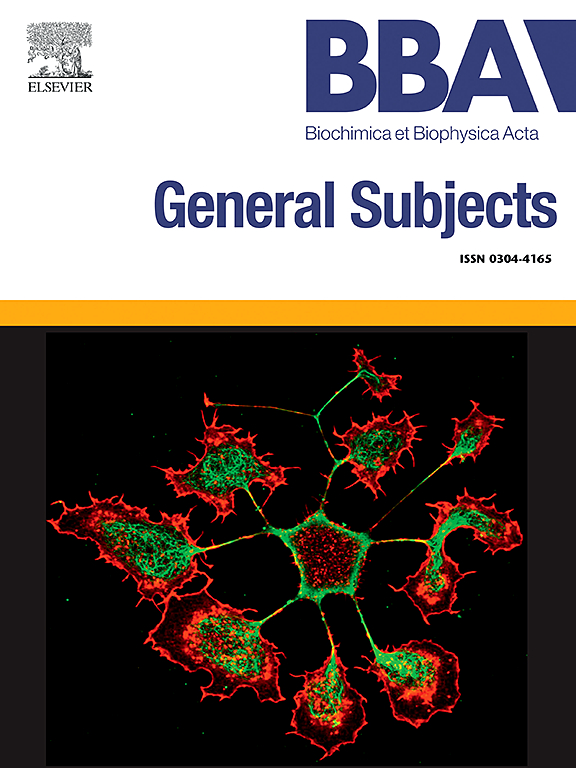Entanglement of vimentin shapes the microrheological response of suspended-like melanoma WM35 cells to oscillatory strains induced by different AFM probe geometries
IF 2.2
3区 生物学
Q3 BIOCHEMISTRY & MOLECULAR BIOLOGY
Biochimica et biophysica acta. General subjects
Pub Date : 2025-02-13
DOI:10.1016/j.bbagen.2025.130773
引用次数: 0
Abstract
Normal and pathological states of cells can be distinguished by their mechanical properties, which are thought to be determined by the organization of the actin network. In the body, cells exist in both adherent and non-adherent (suspended) states, and studies of the rheological properties of spread and suspended cells are needed to gain more insight into their response to strain. Herein, we show that WM35 melanoma cells in adherent and non-adherent states respond differently to oscillatory strain. We used an atomic force microscopy (AFM)-based microrheological approach to study the elasticity and fluidity of the cells, quantified by the storage (G') and loss (G") moduli and the transition frequency fT (G' = G”). Our results show that spread cells are stiffer than the suspended-like cells (plateau shear modulus of 3.51 ± 0.43 kPa vs 2.67 ± 0.34 kPa). We also found, from measurements made with a conical probe, that suspended-like cells are more tolerant to imposed strains. Combining AFM results and fluorescence microscopy of the cytoskeleton, we conclude that the organization and distribution of actin and vimentin within the cell body strongly influence the rheological properties of spread and suspended-like WM35 cells. The data also suggest that phosphorylated vimentin is predominant in suspended-like cells, whereas in spread cells, vimentin intermittent filaments (VIFs) form an assembled network that contributes to higher G'. The entanglement of the disassembled VIFs in suspended-like WM35 cell influences the rheological properties of such cells.
波形蛋白的缠结决定了悬浮样黑色素瘤WM35细胞对不同AFM探针几何形状诱导的振荡株的微流变反应。
细胞的正常和病理状态可以通过它们的力学特性来区分,而力学特性被认为是由肌动蛋白网络的组织决定的。在体内,细胞以贴壁和非贴壁(悬浮)两种状态存在,需要对扩散和悬浮细胞的流变特性进行研究,以更深入地了解它们对应变的反应。在本文中,我们发现在贴壁和非贴壁状态下的WM35黑色素瘤细胞对振荡菌株的反应不同。我们使用基于原子力显微镜(AFM)的微流变学方法来研究细胞的弹性和流动性,通过存储(G‘)和损失(G“)模量和转换频率fT (G’ = G”)来量化。结果表明,扩散细胞比悬浮细胞更硬(平台剪切模量为3.51 ± 0.43 kPa vs 2.67 ± 0.34 kPa)。我们还发现,通过使用锥形探针进行测量,悬浮状细胞对施加的菌株更具耐受性。结合AFM结果和细胞骨架的荧光显微镜,我们得出结论,肌动蛋白和波形蛋白在细胞体内的组织和分布强烈影响扩散和悬浮样WM35细胞的流变学特性。这些数据还表明,磷酸化的vimentin在悬浮样细胞中占主导地位,而在扩散细胞中,vimentin间歇性丝(vif)形成一个组装网络,有助于提高G′。在悬浮样WM35细胞中,游离vif的缠结影响了细胞的流变性能。
本文章由计算机程序翻译,如有差异,请以英文原文为准。
求助全文
约1分钟内获得全文
求助全文
来源期刊

Biochimica et biophysica acta. General subjects
生物-生化与分子生物学
CiteScore
6.40
自引率
0.00%
发文量
139
审稿时长
30 days
期刊介绍:
BBA General Subjects accepts for submission either original, hypothesis-driven studies or reviews covering subjects in biochemistry and biophysics that are considered to have general interest for a wide audience. Manuscripts with interdisciplinary approaches are especially encouraged.
 求助内容:
求助内容: 应助结果提醒方式:
应助结果提醒方式:


